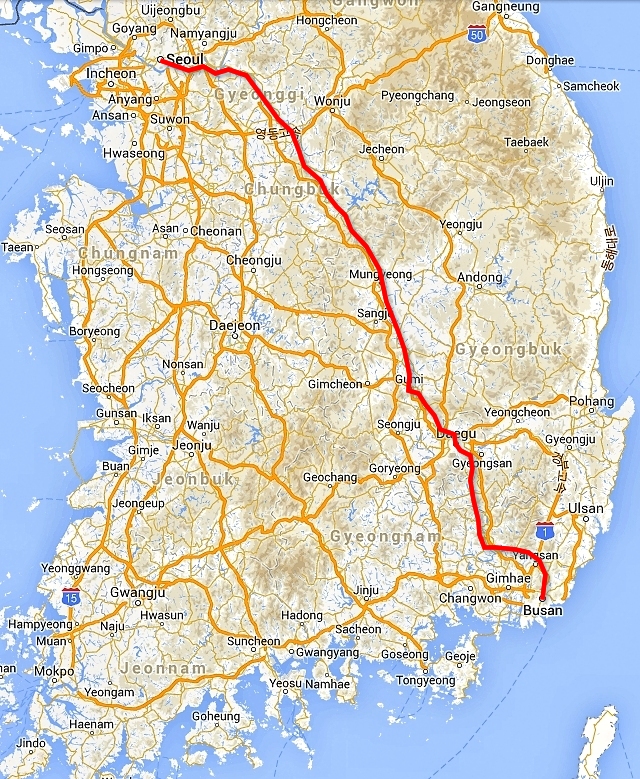
Nothing compares to the simple pleasure of a bike ride. J.F.Kennedy
Search this website
To Busan
Soul, Paldang, Yangpyeong, Ipobo, Gancheon, Chungju, Suanbo, Yeonpung, Mungyeong, Andong, Gumi, Waegwan, Daegu, Namji, Mulgeum, Busan
Korean Cycling Routes
Korea is proud of its long cycle trails and frequently promotes them in Tourist Information Centers. I received several maps and brochures which, all except for one, were in Korean. As the English version only had the local names in English, I lacked a bridge between the English and Korean maps. The graphics of these maps differed a lot from each other, which made their comparison very demanding. This is why I would like to apologize if the local names are not accurate. It was rather difficult, when arriving in a local village where I would find the name only in Korean. If I was very lucky, I could identify the village on the English map by its location. GPS is almost of no help with this.
Currently the longest cycle trail leads from Seoul to Busan and consists of three connecting trails along riverbanks. The first one – along the Han River – is a totally separate cycle path and almost completely flat. The only ascent is 60 meters, however at a 15-degree inclination. The second one – Saejae – is hilly, extending to 568 meters above sea level, leading along small local roads with little traffic. The third one – along the Nakdong River – leads mostly along separate cycle tracks and has several short yet sharp ascents. Some parts of it are only suitable for mountain bikes, but can be bypassed on the road. Even though Korea is quite hilly, cycling along the riverbanks is very easy with the rare occasion of having to work hard uphill. I could follow the last section on the detailed English map, so the information about its location is more exact than for the previous two paths.
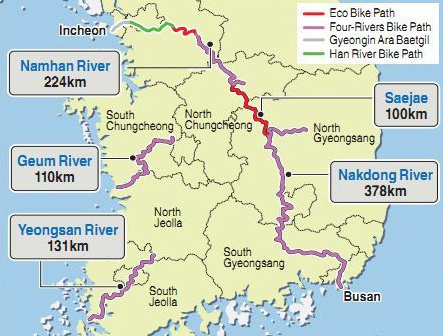
Seoul: Map of Korean cycling trails
New cycle paths were being prepared. In 2015 the new paths should be completed along the East coast and around Jeju Island. A path along the demilitarized zone on the border with North Korea should be ready in 2019. The popularity of the trails has also increased, thanks to a smart marketing trick: for a small fee (3000 wons) a Cycle Pass pass can be purchased. This Pass can then be stamped at various registration boxes along the bike trail, confirming that one has been there. For every trail cycled, a diploma is received at the K-water Centers. If one cycles along all the bike trails, then receive a nice medal. Those who know me will realize that I have no need to prove something so obvious to myself. However, most cyclists were diligently having their Passes stamped, sometimes even for their friends who were not present.
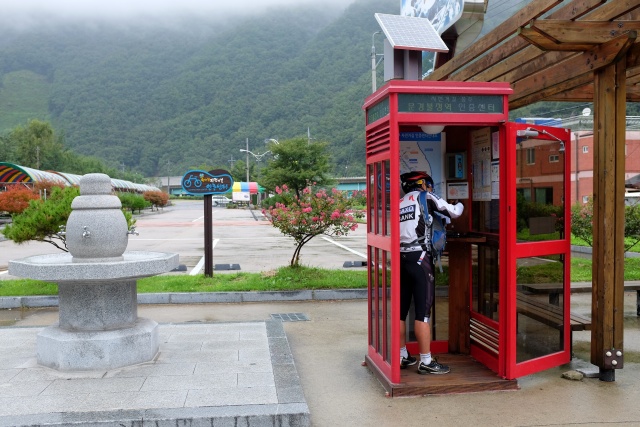
Near Mungyeong: Certification booth for stamping of Cyclist Passports
Swiftly down to the River
I assembled the bike in a very small room, where half of the room was filled by a bed, with a pillar built in the middle of the room. Removing the bike from the room was tricky. At one point, it even seemed that I might have to take the bike apart. I finally succeeded, took the untested bike outdoors, hung the panniers on it, tested the brakes and got going. Luckily it was a Sunday with little traffic, so I could cycle in the streets and not toil along pedestrian paths. I took the shortest route to the Han River along which a bike path runs. I arrived close to the river within 30 minutes, but could not reach it due to the highway. Then I battled around estate parking lots, before finding a footpath which took me to the desired bike path.
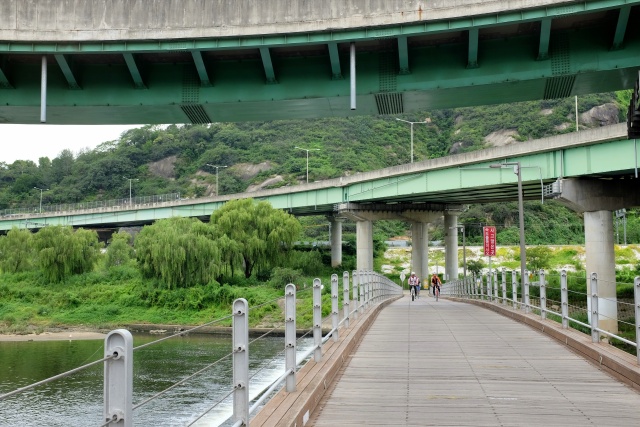
Seoul: Riverside bike path
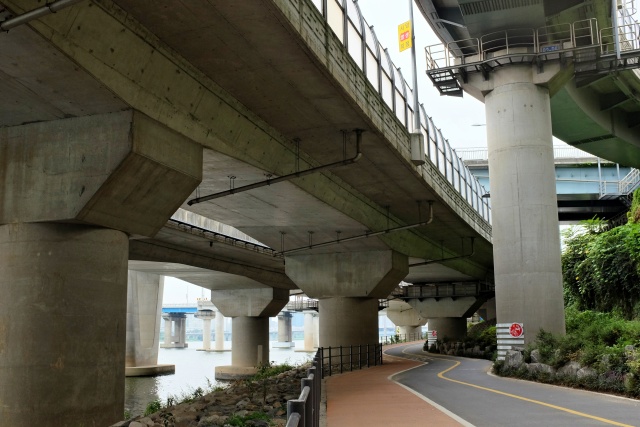
Seoul: Part of the bike path with a very industrial touch
The bike path was easy, wide and with a good surface. The surroundings, however, were not very pleasant. It felt as if I was in an industrial zone. Plenty of cyclists everywhere, as one would expect on a Sunday. I really had to watch out for the children cycling from side to side. The trail on the outskirts of Seoul went through meadows filled with flowers with available benches where tired cyclists could rest. The path was also used by people on rented tandems and family 4-wheelers. I passed several bicycle repair stores and a whole row of bike rental places and pubs. The trail became a thriving business enterprise.
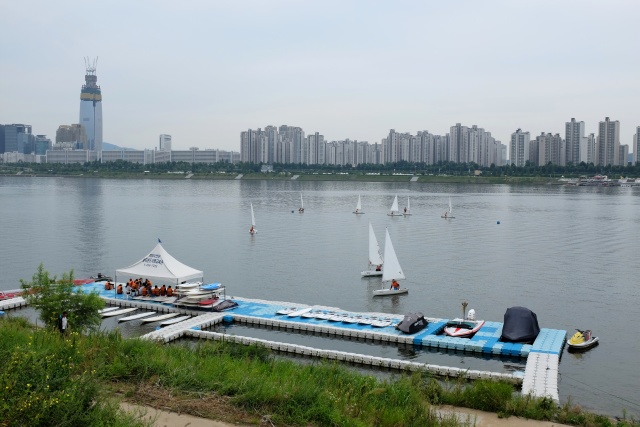
Seoul: Sailboats on the river
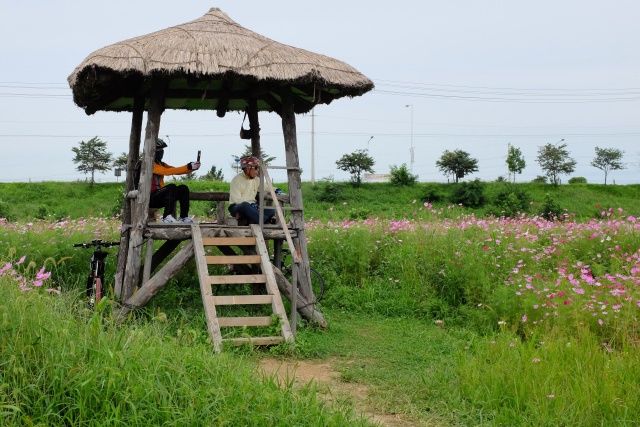
Seoul: Hideout for resting cyclists
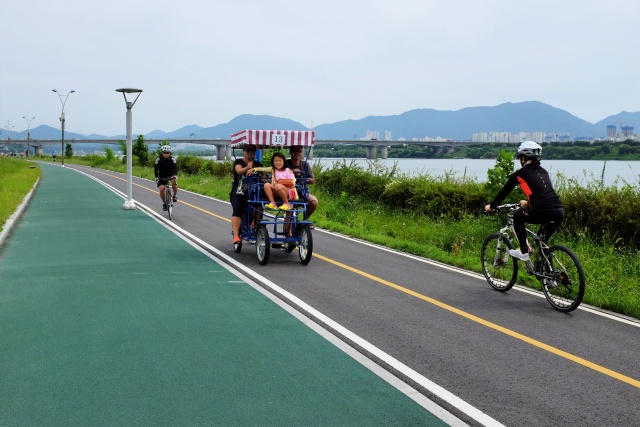
Seoul: Popular family cycle rental is next to the bike path

Seoul: One of the less equipped service stations
Cycle Path Beside the Han River
The trail begins about 30 km from Seoul at the Paldang Bridge. I stopped at a restaurant for lunch, where the restaurant employee locked my bike with his own lock, so I would not have to bother with mine. As expected, the biggest problem turned out the choice of meal. Restaurants in the countryside do not display models or photos of meals served, so the only option left was to walk through the restaurant, check what others were eating and point at the desired dish. But even this did not guarantee success. I ordered soup with noodles, which rich brown color reminded me of beef stock soup and I received noodles in cold brown jelly. Although it was rather strange, it tasted good and I ate it all. Hunger is the best chef.
Part of the trail passed along a disused railroad. Passing through the total of seven tunnels was rather interesting. I could hardly see anything when inside them. Once I had to try really hard on my fully loaded bike not to crash into a girl who had got in my way.
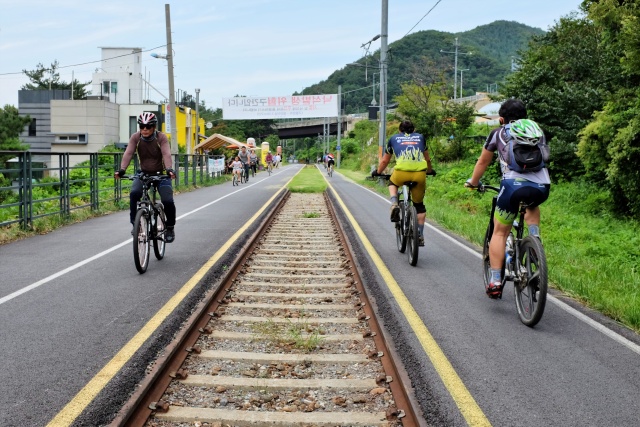
Near Paldang Bridge: The occasional abandoned railway line showed up
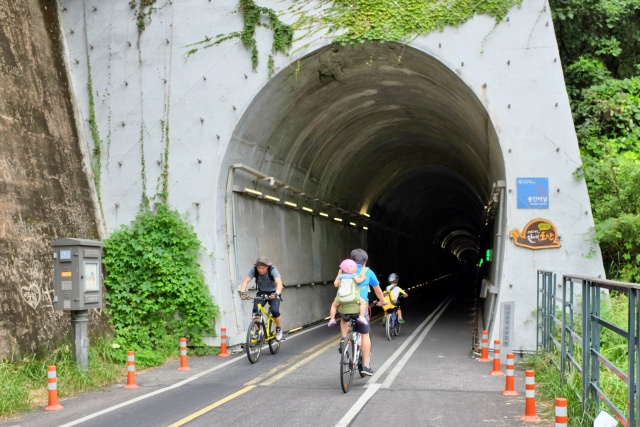
Near Paldang Bridge: Railway tunnels now serving cyclists
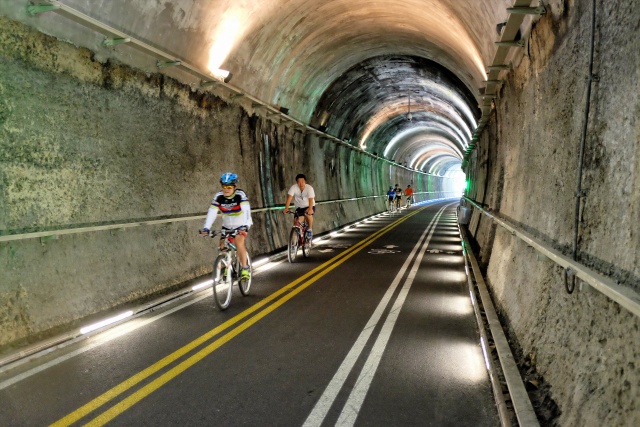
Near Paldang Bridge: In the tunnel
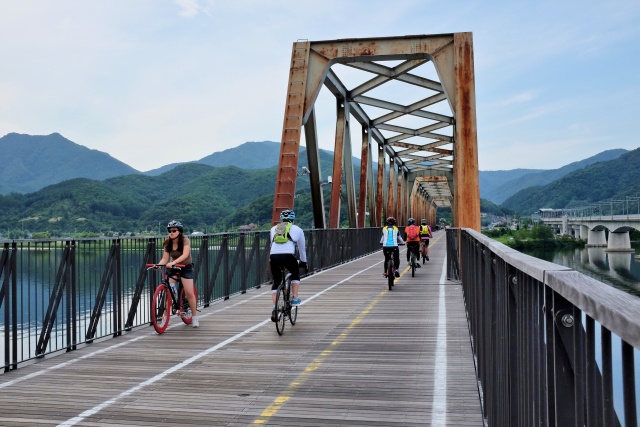
Near Semiwon: Former railway bridge
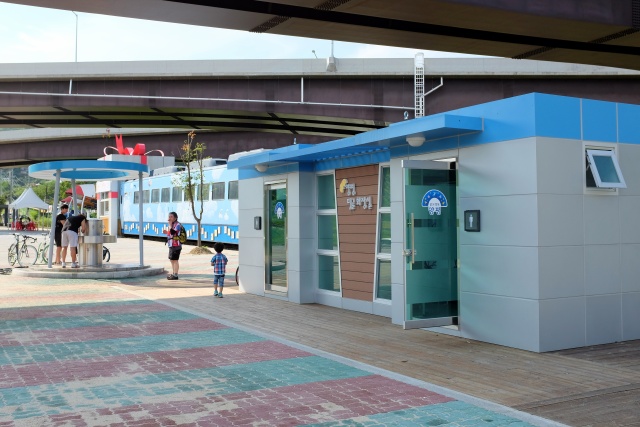
Near Dumulmeori: Bathrooms, drinking water and rail wagon bistro in the background
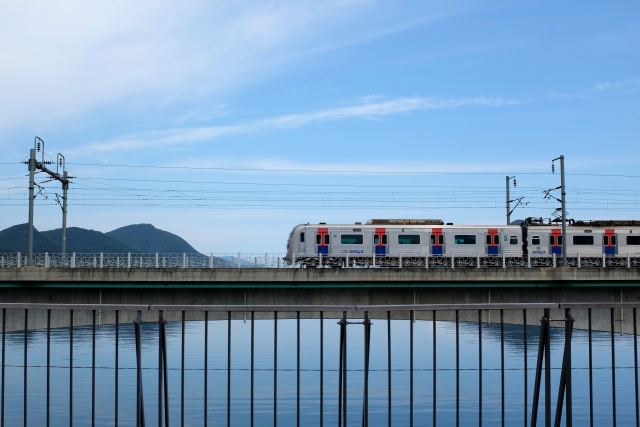
Near Semiwon: Rail traffic is not entirely abolished despite the cyclists
The trail closely followed the Han River and, except for a few steep hills, was totally flat. Most people pushed their bikes up those sporadic ascents and gave me strange looks as I cycled up them on my heavily loaded bike. The river is not used by boats, as it contains many weirs of an unusual and modern design.
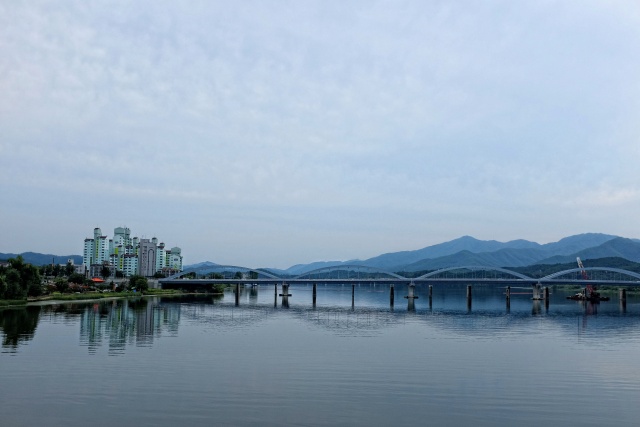
Near Semiwon: Typical Korean blocks of flats flanking the river
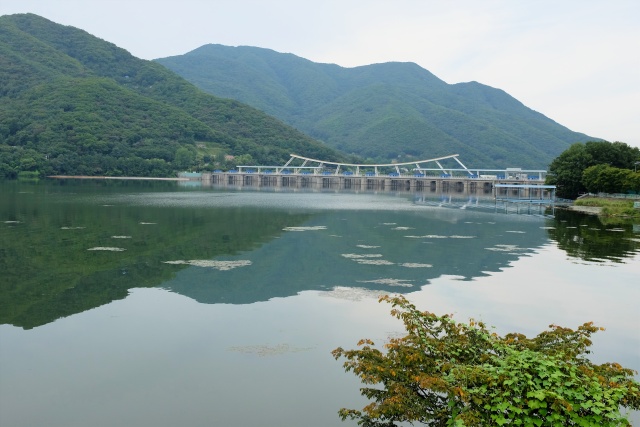
Near Semiwon: Weirs in the Han River are generally of a modern design
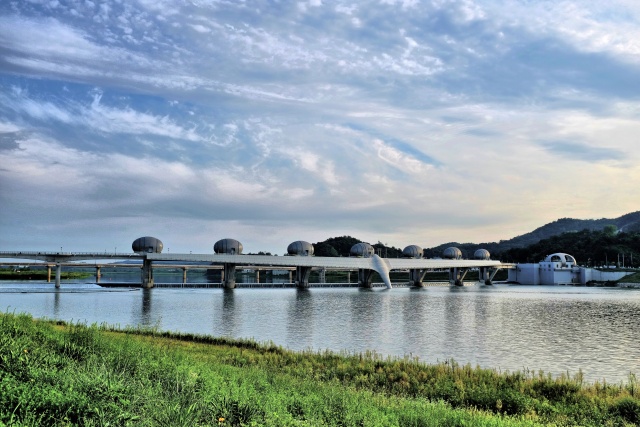
Ipobo: A futuristic weir
I was not worried about finding a place to sleep. There were many sites along the river where I could pitch my tent. I reached Ipobo where there was a campsite. An Ironman Triathlon was taking place in that area. I encountered many tired runners finishing the last kilometers of the marathon. Regardless of their exhaustion, they always greeted me, waved or at least nodded. The campsite was already almost empty, as the runners were leaving it so they could get back to their jobs the following morning. I tried to find someone to pay for the campsite, but was told that it was free and that I only needed to register on the camp's website to reserve a site. There was so much space, so I skipped the reservation. Showers were provided with hot water, the washrooms were functional, so I lacked nothing. I pitched my new tent, which I'd ordered from Big Sky in the USA. They had given me a 30% discount on it and free shipping. So the price would have been quite good, had it not been for the Czech state who charged me a hefty tax duty plus VAT. The tent weighs 1.35 kg, double-layered, free-standing with compartments on both sides for storage of my panniers. So I was very satisfied with it at that stage and did not anticipate even unexpected showers to touch me.
Breakfast was nothing special, tea with two muffins from Seoul. A young Korean caught up with me, he spoke good English and taught me a few basic greetings. Before leaving, he gave me a local specialty — an energy bar tasting like chewy fruit jelly. At the first available store, I got some food and replenished my supplies. Then I spent most of the day along the Han River. I kept meeting the same cyclists, most of them gave me something small to eat, such as home-made rice cakes. I felt bad that I could not give them anything in return, so I purchased some mandarin oranges, so I also had something to give them. Dinner in a pub in the countryside was a success. I pointed at something on the Korean menu on the wall and received a thick beef soup with meaty bones. It was served with rice and several other side dishes – of which I recognized kimchi – fermented very spicy Korean cabbage. One could say that kimchi tests one's loyalty. If you like it, Koreans will favor you even more and immediately bring you even more of it. Luckily I liked it.

Yoeju: The young man who taught me a few Korean greetings and phrases along the way
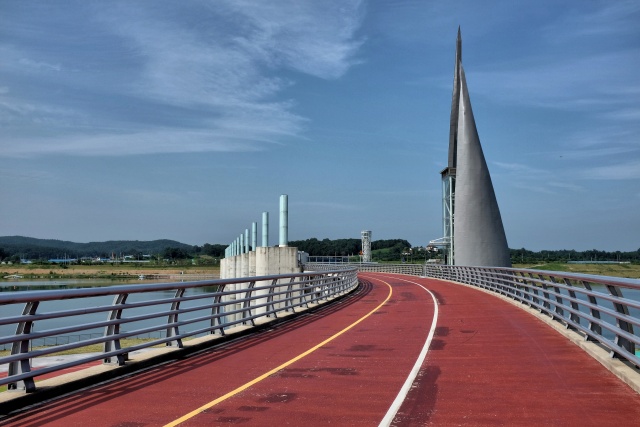
Gangcheonbe: Bike path leading across the weir
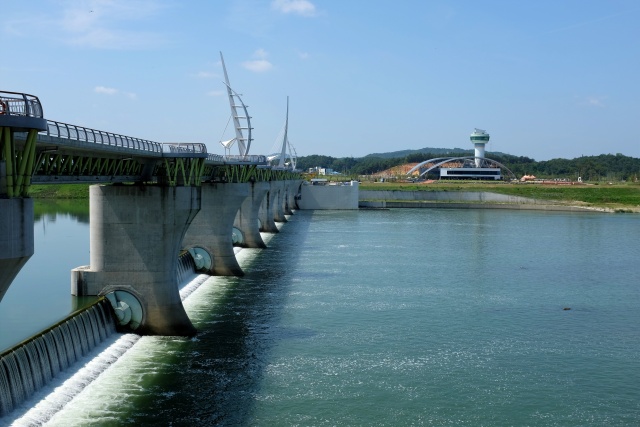
Gangcheonbe: Han River Cultural Center with complete cycling services across the river
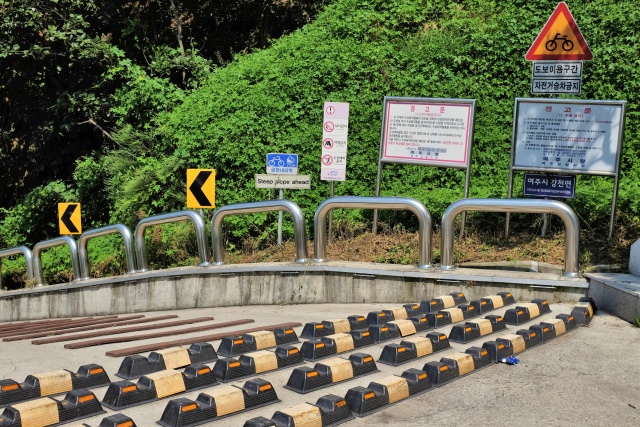
Gangcheonbe: Speed bumps, making it impossible to cycle down the steep hill
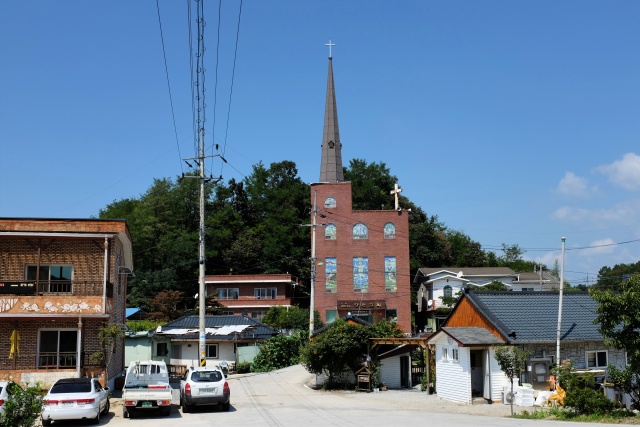
Near bridge Seumgang: Every village square usually, surprisingly, boasts a Catholic church
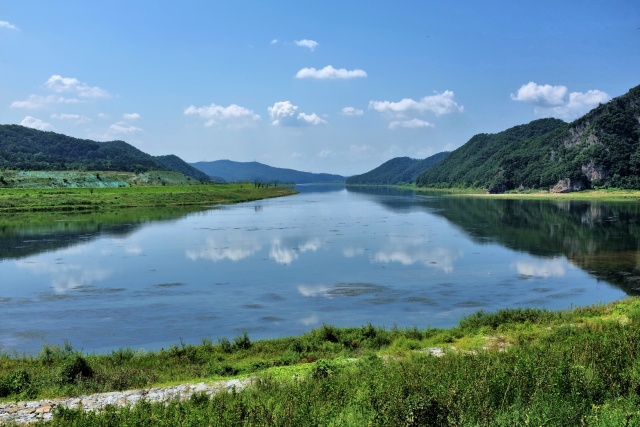
Hongwonchang: Beautiful view of Han River
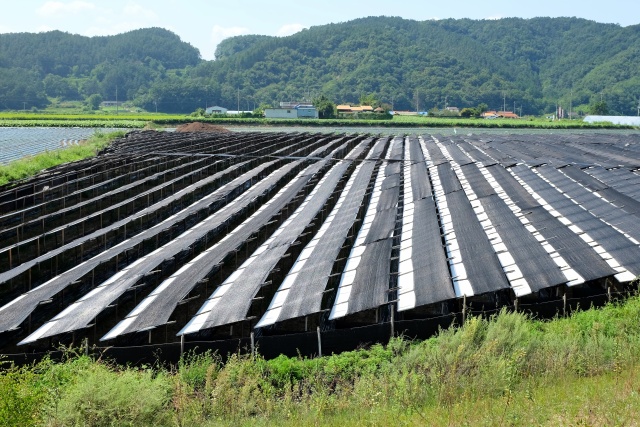
Near Hongwonchang: Back home, we would expect solar panels; these provide shade for cultivated plants
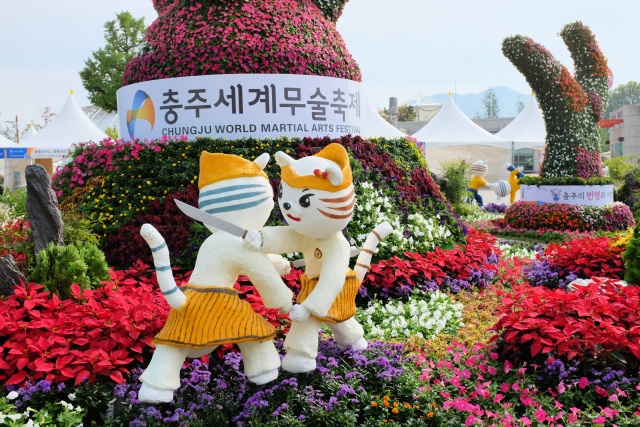
Tangeumdae: Advertisement for a martial arts festival
That night, I picked a spot in a riverside park, as there already was another tent there. Its occupant immediately came to greet me. He was homeless and lived like this during the summer. He could speak reasonably good English and he surely would not have had a problem finding a job with it. But he was not so keen on working. He claimed to be a Buddhist who needed to be in close contact with Nature for at least half of each year. According to his standards, I was also a Buddhist. Regardless of beliefs, he immediately invited me to a pub, where we consumed a few bottles of Soju. Soju is a pure rice beverage with 20% alcohol content and is really cheap. 3 cl costs just a little over 1000 won – depending on the store. Imported alcohol is generally quite expensive in Korea, but the State does not dare to add tax to Soju and other Korean alcohol for fear of its own downfall. This is parallel to Švejk's "The government which increases beer prices would fall" — which, however did not really turn out to be true in the Czech Republic. Public drinking of Soju in Korea can be seen everywhere and sometimes I saw tired citizens sleeping off their hangovers on benches.
Saejae Cycle Path
I left without breakfast and about 3 km later used the luxuriously equipped public bathrooms for my morning ablutions. The following 100-km long stretch of the trail was known to have the most steep hills of all the marked cycle paths in Korea. The path first followed the river, then dived into the forests. However, I still did not feel any increased demands on my legs. I easily reached Suanbo Hot Springs. The beginning of the rain convinced me to try the local 54-degree hot baths with their extraordinary healing powers.
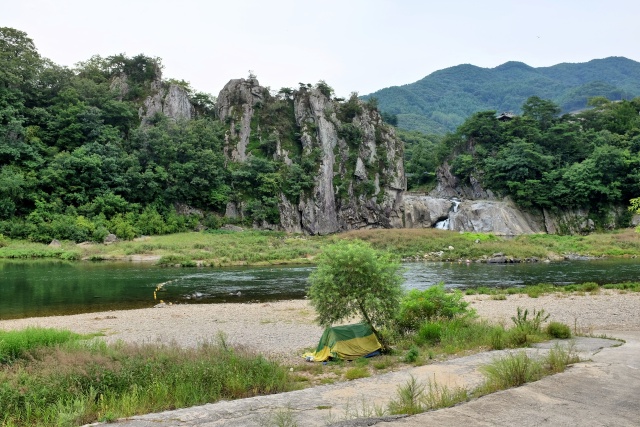
Near Tangeumdae: Hilly landscape and small waterfall in the background
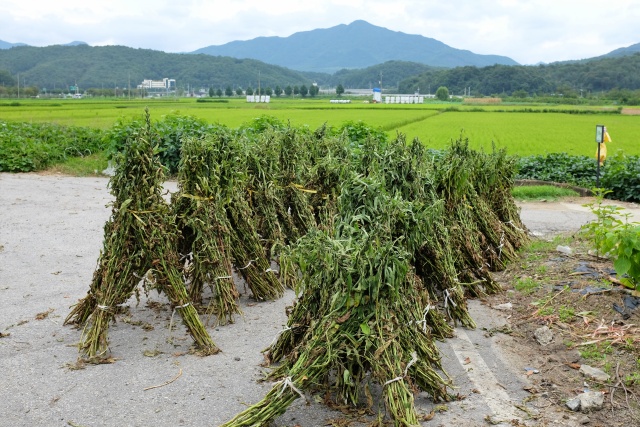
Near Suanbo: Drying soybeans?
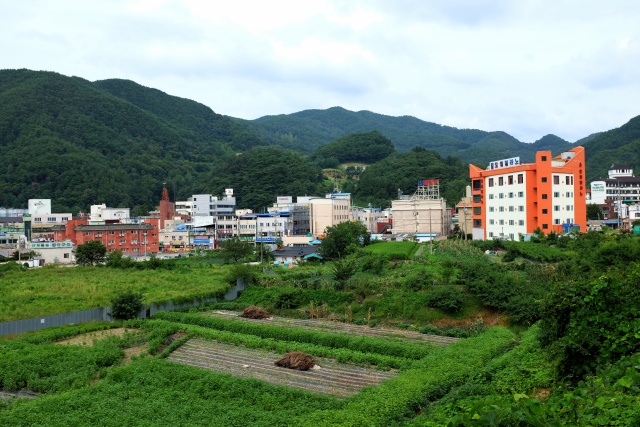
Suanbo: View of the resort
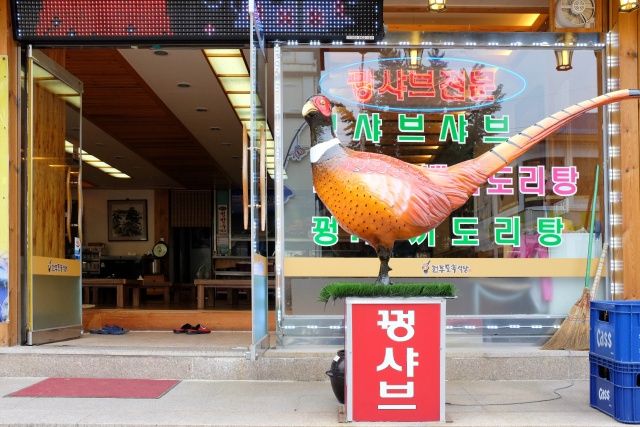
Suanbo: Pheasant is the local specialty and this restaurant advertises accordingly
I was accommodated in a hotel for cyclists (about 600 CZK or $30) where I could take my bike into the room. I found the spa quite time-worn, but bathing in its waters was fantastic. In my hotel they had a Japanese-style spa. I knew right away what to do and how to do it. I tried the local sauna, cooled myself down in the icy water and then lay around in waters of various temperatures until I was exhausted. It rained heavily throughout the night and I was worried that I might get stuck there for another night. I had already tried the local specialty – pheasant – so I had no reason to stay there any longer. The rain stopped at 10:00, so half an hour later, I got going again, regardless of the heavy downpour.
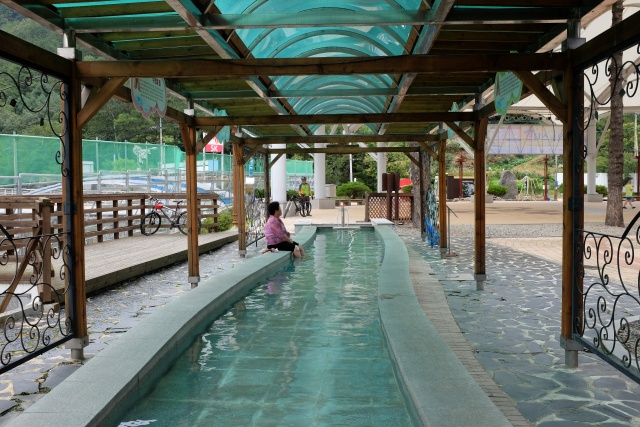
Suanbo: A public foot spa

Suanbo: The light arches were turned off in the evening; it was obviously off-season
The steepest hill on the whole trail lay ahead, so I was curious to see it. Its description was rather frightening, there was a warning about this terrible hill. It was still drizzling and the clouds were very low. Yet the architects of the trail had not forgotten a thing. After every kilometer there was a sheltered pavilion for a rest, slopes were provided with wooden fences, to prevent cyclists from falling down the hillsides. However, this was no hard labor – the ascents were easy and I cycled up all of them in the middle chainwheel.
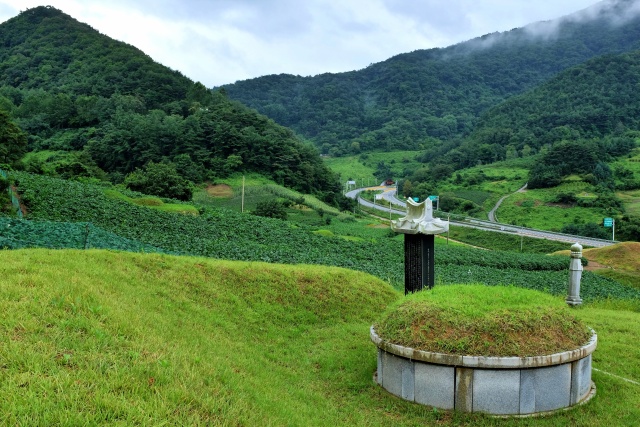
Near Suanbo: Graves
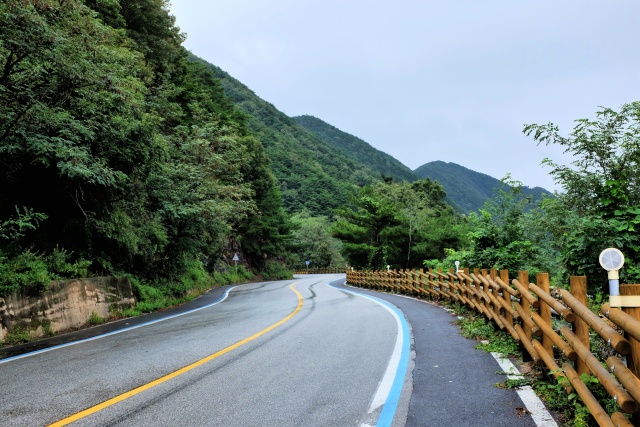
Near Suanbo: Crash barriers protect cyclists from riding off the steep hillside
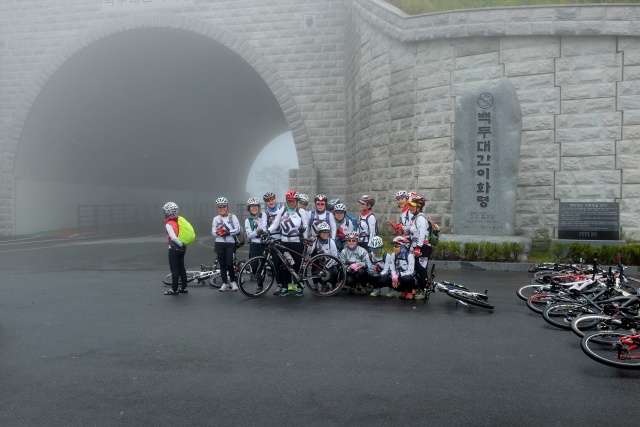
Ihwaryeong Hill: At the summit of the highest hill on Seoul – Busan bike path
The weather on the top of the hill was terrible, minimal visibility, everything covered in clouds. A group of female cyclists dressed alike, were celebrating wildly on reaching the summit. They all went to have their Cycle Passes stamped at the stamping box. I did not participate, which provoked quite a surprised reaction, "Doesn't he want a medal?"
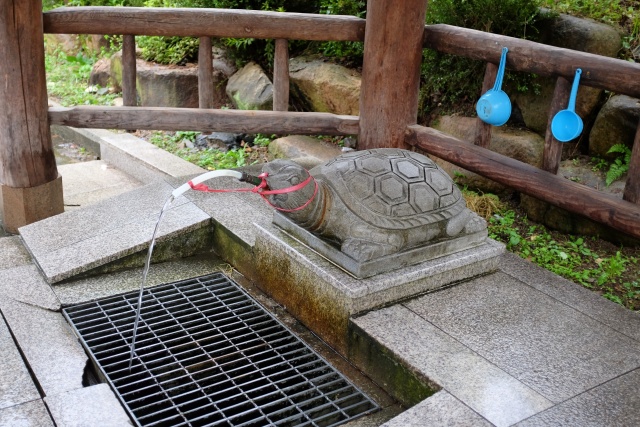
Near Mungyeong: A water spring by the road
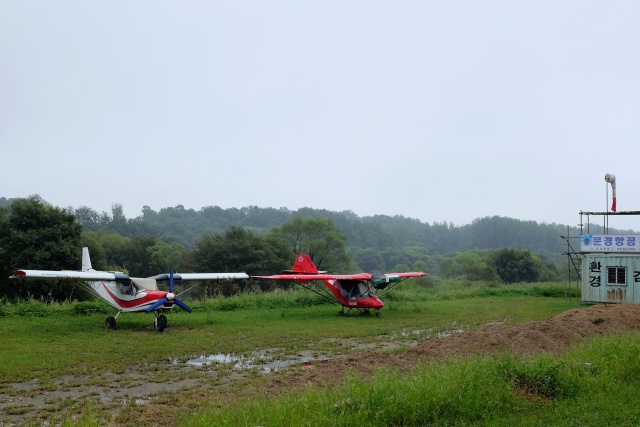
Near bridge Sangpunggyo: Local airport
Cyclists' Accommodation
On the way, I spoke to two cyclists – one was a university student in a 4-year cooking program, the second one was a Baptist pastor who had studied in the USA. I met them again at Sangpunggyo Bridge, at the end of the Saejae cycle trail. I wanted to sleep over there, but the dry toilets were dirty, there was no running water and difficult access to the river. The lads told me that they planned to sleep over in accommodation for cyclists for 30000 WON (600 CZK, $30) which included dinner and breakfast. They were waiting for a car to take them and their bikes there. I joined them. A large pick-up truck arrived, with already four cyclists in it. There were really too many of us, but we finally managed to squeeze in with my luggage and two of the boys had to travel on the back of the truck.

Hostel near bridge Sangpunggyo: Fellow cyclists acting silly at dinner – already a bit tipsy

Hostel near bridge Sangpunggyo: My roommates
The accommodation was actually on a farm, whose biggest income came from the fruit grown, which tasted something between an apple and a peach. Mess everywhere, but the accommodation was quite clean and the showers were hot. We put together our dirty clothes, threw them into a giant washer and were called for dinner. Madam took me under her wing and made sure I had my fill. I did not resist at all and really ate till I was stuffed. Another group of people had already started drinking before dinner. They drank mainly Soju and of course invited everyone around them to join in. I tried a little, but it was not for me.
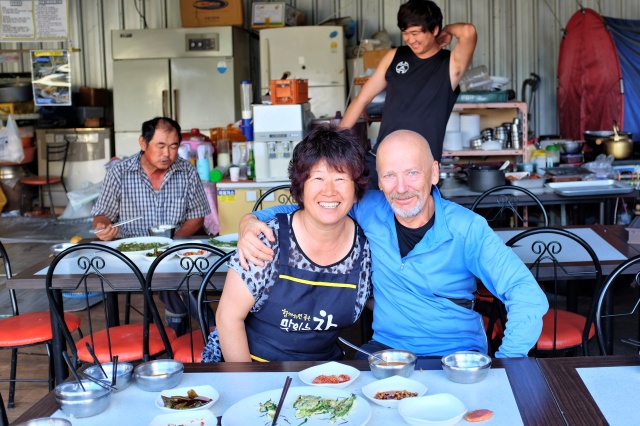
Hostel near bridge Sangpunggyo: The lady of the house made sure I ate as much as I could. Her husband and son in the background
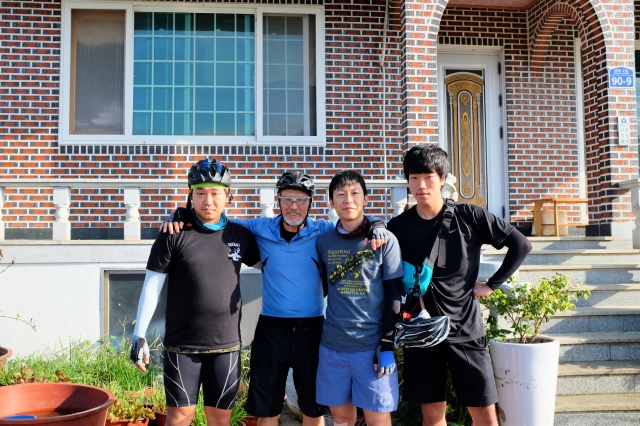
Hostel near bridge Sangpunggyo: My roommates – on my left: a student from the Culinary University, on my right: a Baptist pastor
Cycle Path along the Nakodong River
It wound along the river with many weirs, crossing many of them to the other side. The weirs and entire water basin were maintained by the K-Water firm, who had tried to turn every weir into an exhibition of its own propaganda and always with something a little extra. You could leave messages on stickers on large panels. You could fold and paint your little paper boat and place it in a transparent box. You could use binoculars free of charge — installed to observe the birds. The trail also offers several large modern centers, which, apart from exhibitions, also house restaurants and stores.
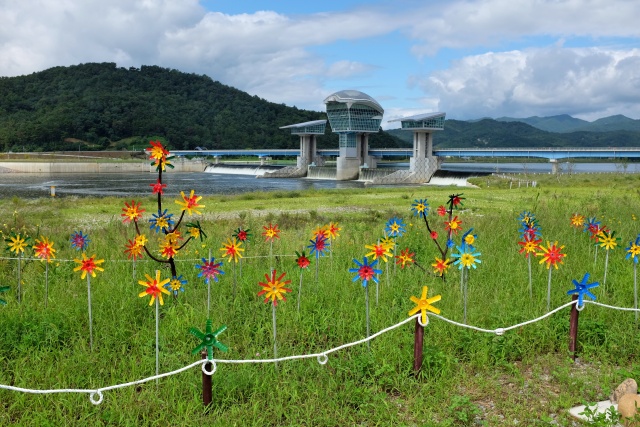
Gumibo: Another weir with an interesting design
Silicon Valley
Gumi City is the Korean equivalent of Silicon Valley. The headquarters of developers and computer chip factories are located there, as well as the huge LG factory which produces displays, many say, which are the biggest in the world. An accompanying phenomenon is the chemical stench, very intensive in some parts. But success could be seen at every step. There were many generously equipped parks and playfields along the riverbank, a viewing tower with free elevator, good quality surface of cycle path – sometimes with solar-lit middle lane, designer railing. I really didn't get how such an agriculturally oriented country could have reached such an enormous commercial boom. It must be well managed, although they also had (and probably still have) huge problems with the corruption of politicians. It seems that actions against corruption do not lead to good fortune.
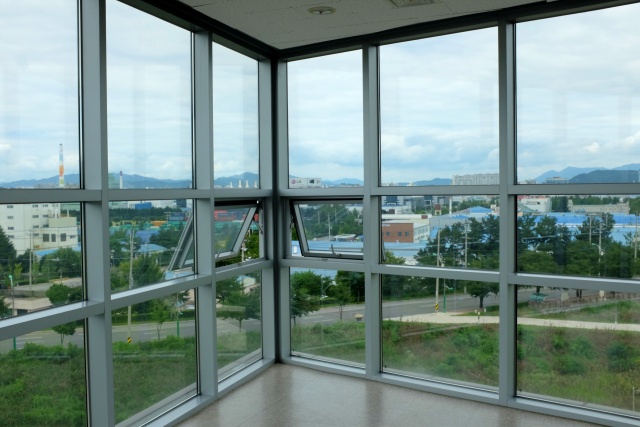
Gumi: View over Korean Silicon Valley
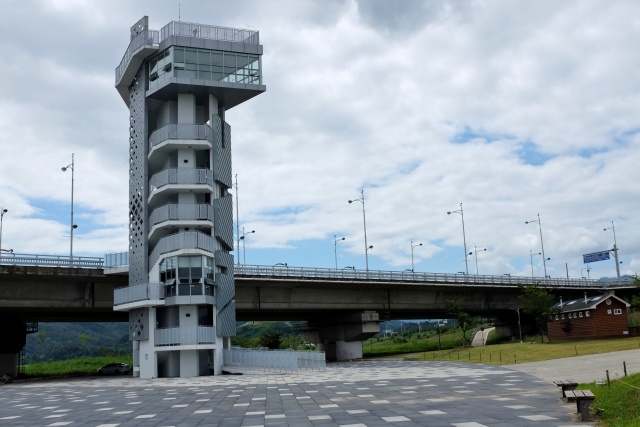
Gumi: Watchtower
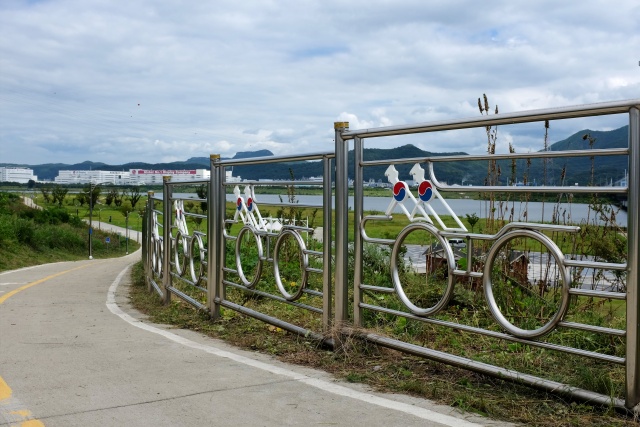
Gumi: Railings with a cycling theme

Gumi: In the background, LG – world's biggest display factory
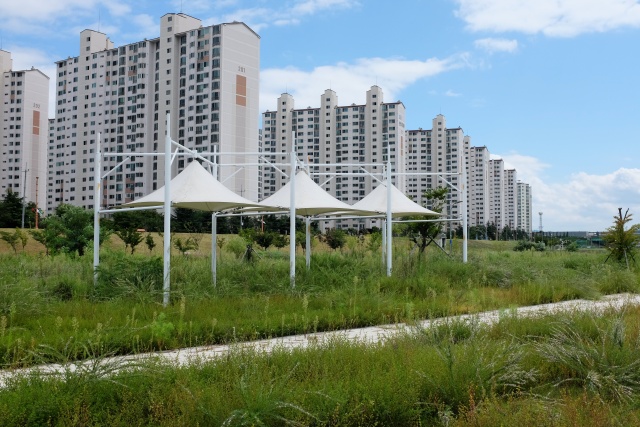
Gumi: Typical Korean apartment blocks with protruding elevator shafts
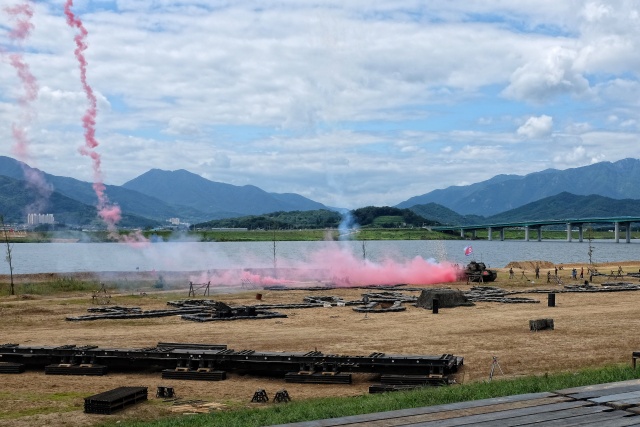
Near Gumi: Filming of a war movie
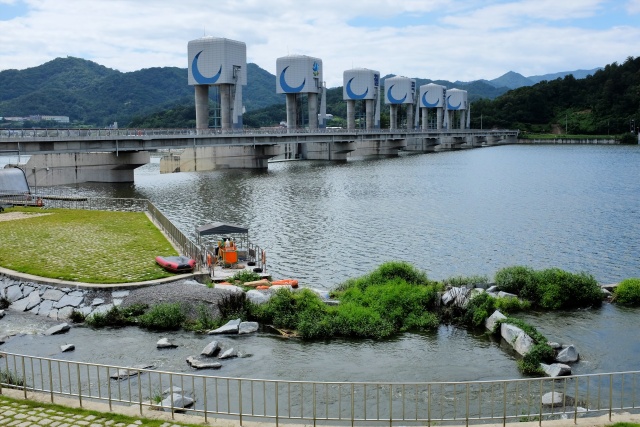
Chilgokbo: Another weir in Nakdonggang River
Waegwan is famous for its market, so I left the trail and headed there to find something to eat. Another cyclist showed me the way and also recommended what and where to choose a meal. I liked paejon — a cake made from cabbage leaves and pancake dough. They also call it Korean Pizza. I bought some more to take away for breakfast.

Waegwan: The cyclist who showed me the way to the snack section of Waegwan market
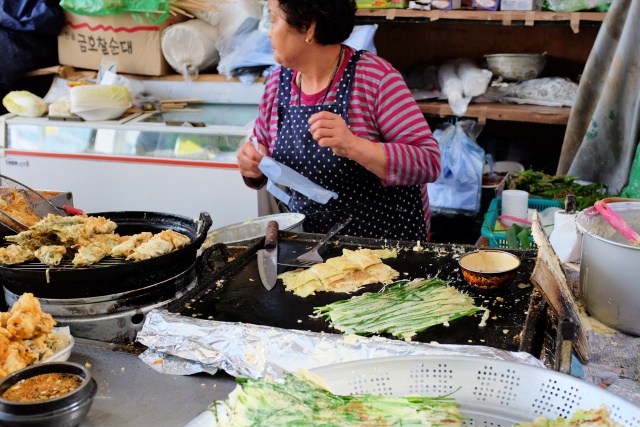
Waegwan Market: The woman preparing ”Korean pizza” for me – green leaves with pancake dough
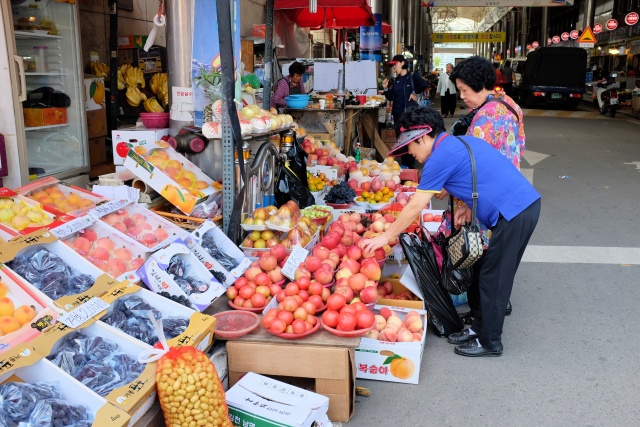
Waegwan Market: Wide selection of fruit and vegetables
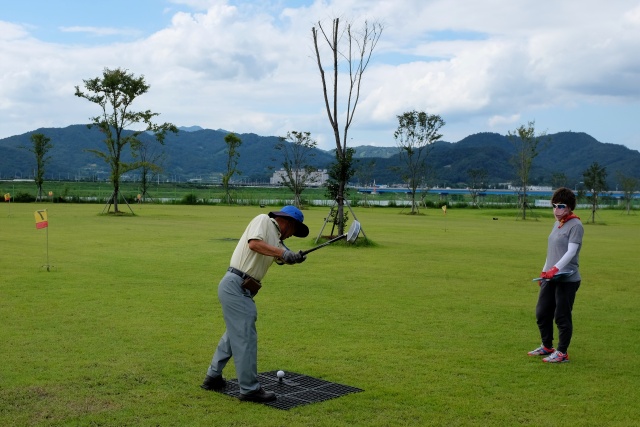
Near Waegwan: The very popular ”golf” for retirees
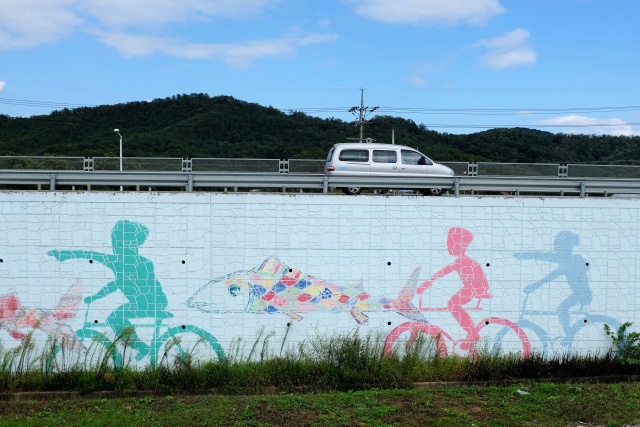
Near Waegwan: Retaining wall decoration
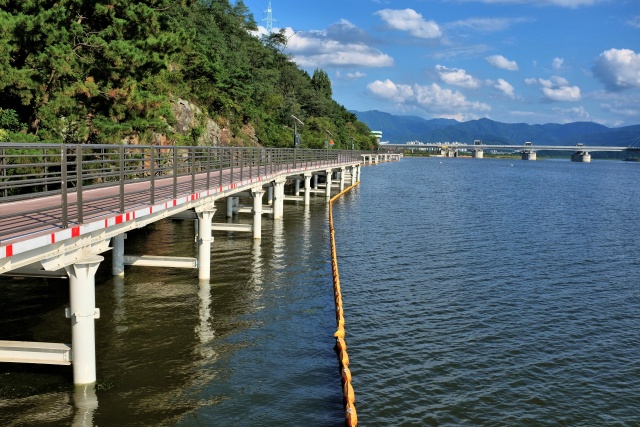
Near Daegu: Bike path construction here was certainly not cheap
Deceitful Bacholi
The evening was approaching, so I searched for a place to stay. I found both running water and washrooms in Leports Park in Daegu city. I crossed a bridge and headed to the city for a meal. There were several local folk restaurants. I ordered a meal in one of these. They asked me if I wanted Bacholi with it, but I did not know what that was. I suspected something was up, all the people around were nodding their heads: "try Bacholi". So I listened to them and ordered it with my meal. I received a can of weak rice wine, containing about 8% alcohol. It was not strong, but I received almost a liter of it. In the heat, I really started to feel its effects, resulting in an energetic sign-language conversation with the locals. Finally a young Korean lady, who had lived in the USA, turned up, and our conversation could make some sense. On the way back to my chosen park, I cycled very carefully. I did not want to break my neck anywhere. Luckily the route followed the cycle path almost all the way.
By the way, it was Makgeolli which I had drunk, but I'd heard them saying Bacholi.
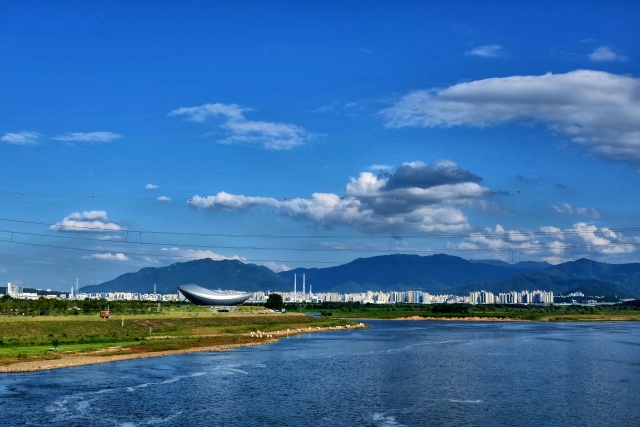
Daegu: View of the city
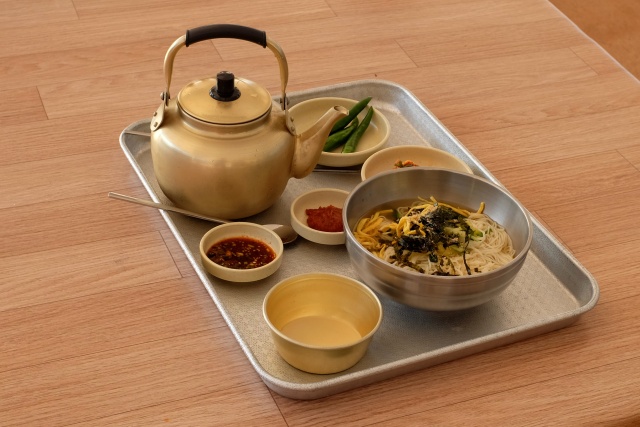
Daegu: My dinner – insidious Makgeolli in the pot
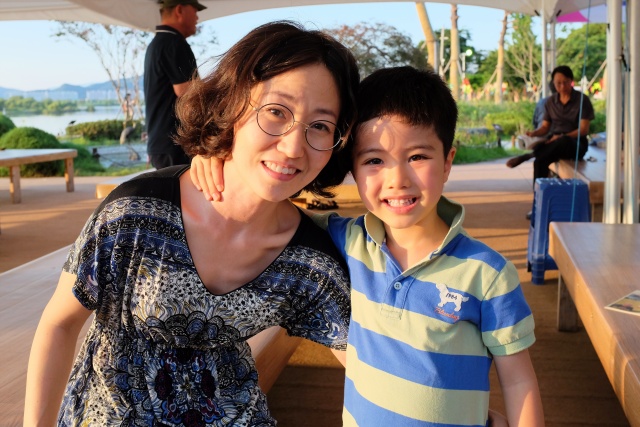
Daegu: A Korean woman and her 4-year-old son from USA
The following morning, I managed to get rid of the slight hangover by cycling in a beautiful environment. I sweated out the rest of it on the steep ascent on a small road leading to the historical Dodongseowon Confucian Academy. I was not so impressed by this site, as the most beautiful building – the temple – was not accessible. I left the bike path to eat in Yangcheon village. They had a standard selection of soup in containers at the 7-Eleven store, which one only needed to pour hot water over – which was also available. On the other side of the crossroads, I noticed a sign for "Mexikana". I could definitely have done with a burrito. They only served chicken. The owner fried a whole chicken for me, so I took half of it away for my dinner. Locals in the pub were drinking beer with the owner and immediately poured one for me too. I had to refuse it, my rule was never to drink during cycling.
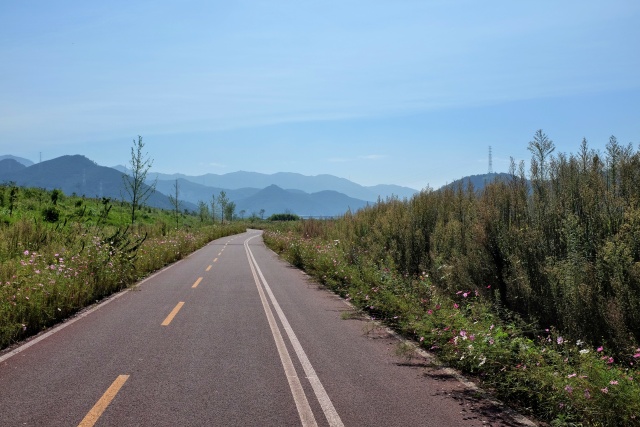
Okpo: Lovely landscape and beautiful weather
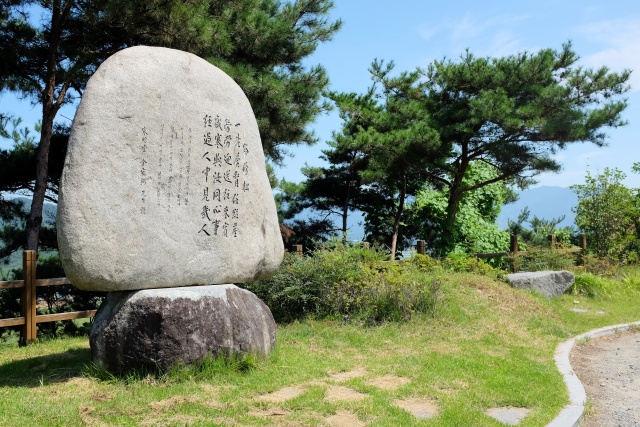
Dodogon: On the summit after a steep climb – 14% inclination
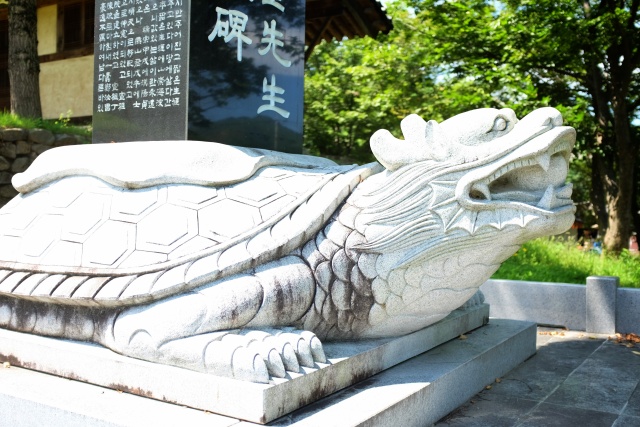
Confucian school Dodongseowon: A turtle in front of school entrance
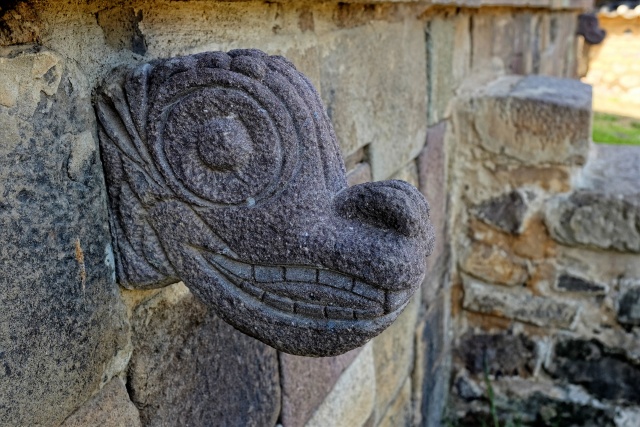
Confucian school Dodongseowon: I would expect such a head only somewhere in Mexico among the Toltecs
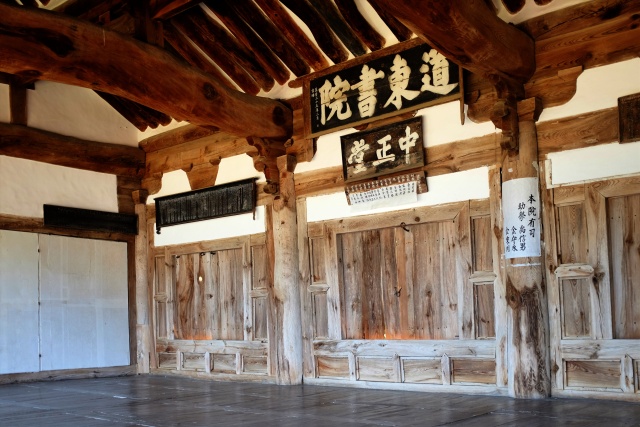
Confucian school Dodongseowon: Hall where teaching is conducted
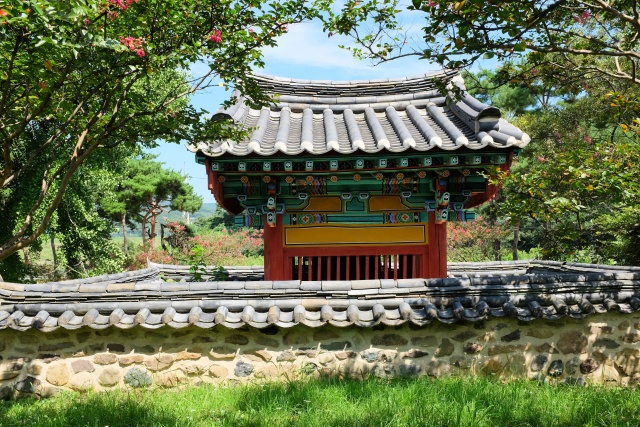
Confucian school Dodongseowon: One of the pavilions
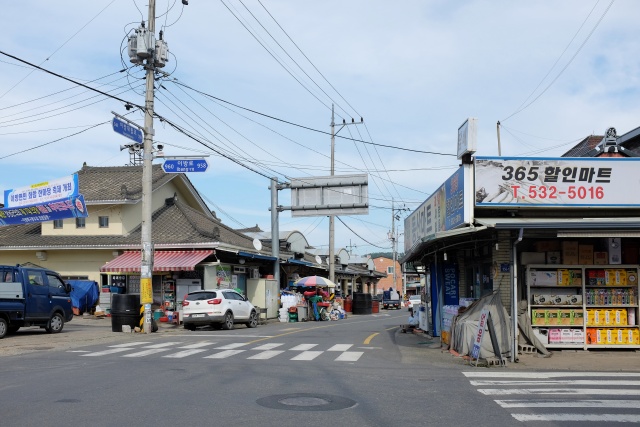
Jangcheon: Village center
Evening was approaching, yet I still had a few hills to conquer. According to the map, the road was suitable for mountain bikes. This was the first time I took out the GPS and located Namji, beyond which I knew there was a campsite. The GPS chose a 55-km route. I located my own route and reduced it to 30 km. Shortly after sunset, I pitched my tent in a totally empty, yet immense campsite, although it was just before the weekend. The camp was partly closed, only one bathroom was open, but, most importantly, there was cold running water. I even had the possibility of recharging my camera battery.
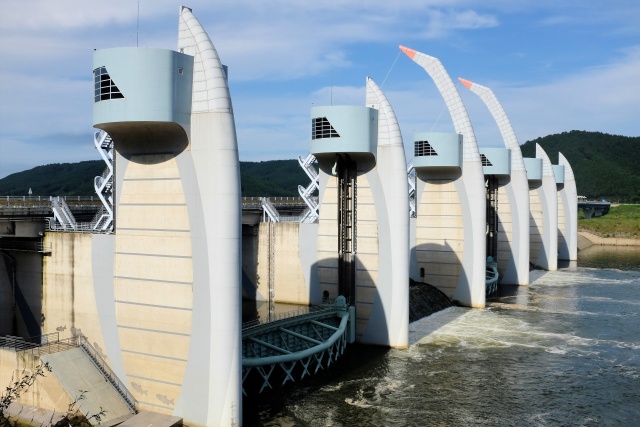
Near Jangcheon: Weir in Nakdonggang River

Near Jangcheon: Bridge decoration
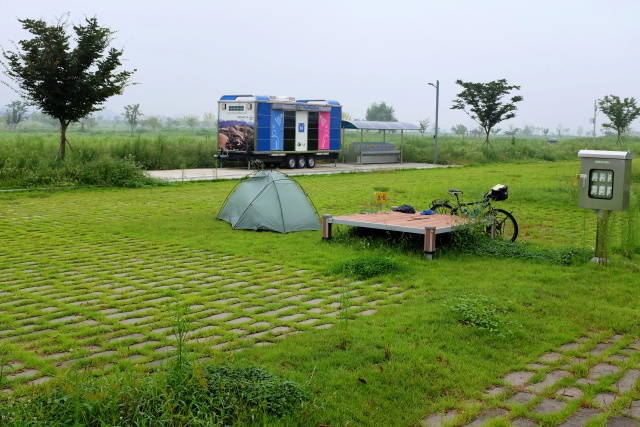
Namji: All by myself in this huge campsite
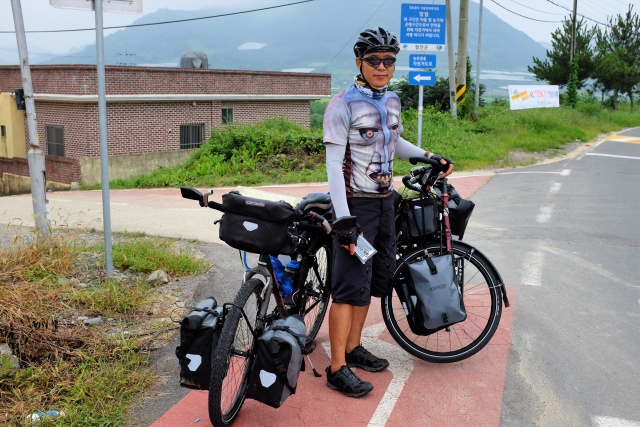
Gilgok: Korean cyclist, fully loaded like me, heading in the opposite direction
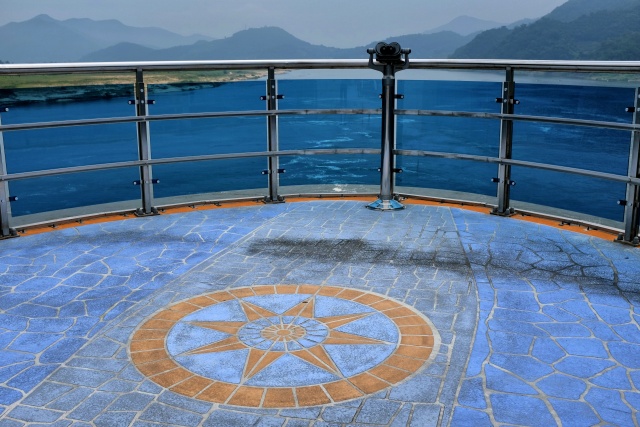
Bonpo: View from the weir, with binoculars for bird watching

Bonpo: I left a typical Czech inscription on the weir's presentation room notice board
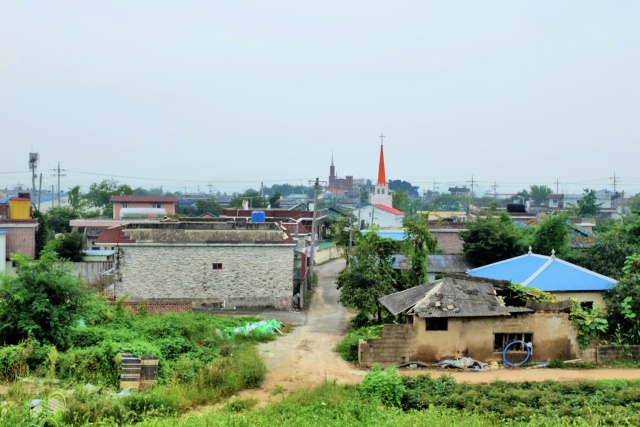
Bukbu: This village does not give the impression of being tidy
The main event of the following day was a late lunch in a fishing pub on a cliff above the river. I pointed at a big bowl of soup being eaten by a couple at the next table. It contained a boiled fish, including the head, fins and gills. I even received a stare from the little boiled eyes that surfaced while eating it. It was very tasty, although quite spicy, but it was quite difficult to eat – loads of bones, meat boiled into small fibers. At least I got some proper practice in fine motor skills while trying to eat it with chopsticks. The roe and small baked fish about 1 cm long on bowls beside were delicious. The next course was a real bomb – 3 chili peppers topped, just in case, with chili paste. I ate one of the peppers to show off. I got uncontrollable hiccups and broke into a cold sweat all over. I would skip this 'dessert' the next time. For dinner I took it easy and ate at some old woman's place by the roadside, where I had my favorite ramen. I also wanted to buy a beer there, but it was overpriced. I did not hesitate to purchase one in the nearest town. It was getting dark, there was running water in the park (typical mushroom-like fountain with 8 faucets). I had a wash and headed for a place to sleep. 2 km later I found a meadow with a washroom and several family tents, so I simply joined them.
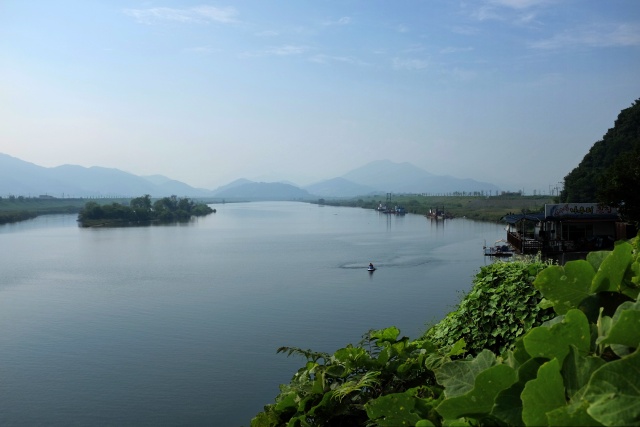
Samrangjingyo: Fishermen's pub (on the right) where I had a meal
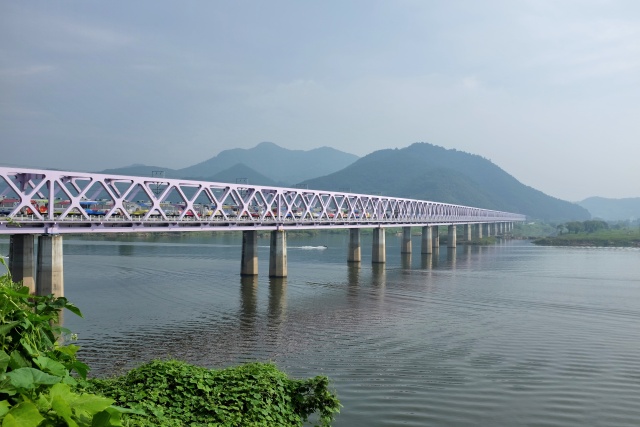
Samrangjingyo: Railway bridge
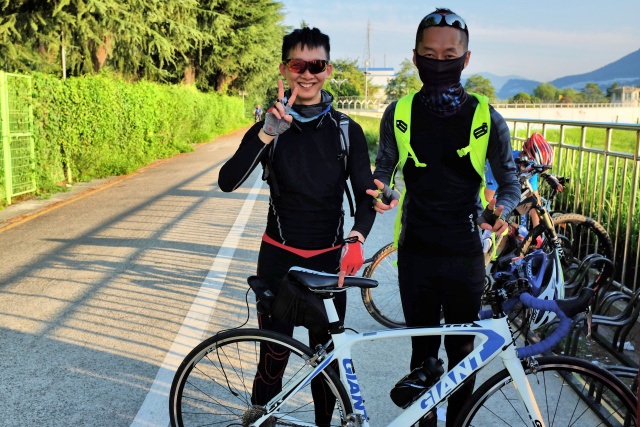
Yangsan: These guys were going to Seoul – traveling light
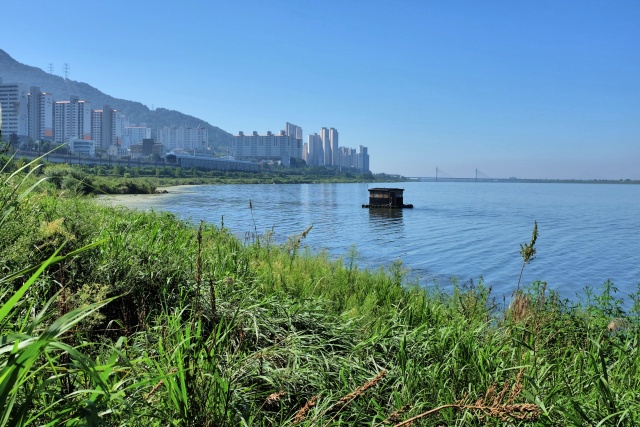
Busan: Suburbia
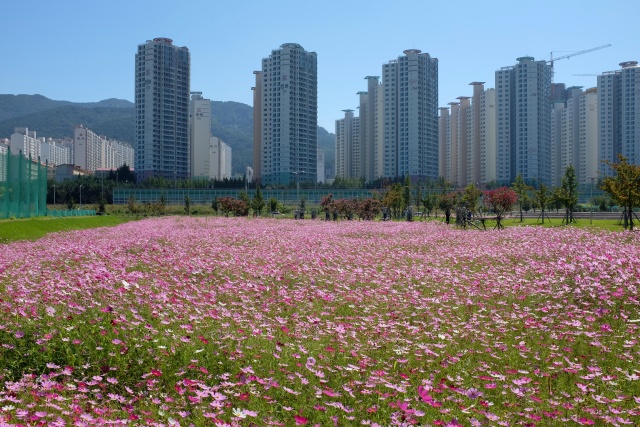
Busan: Flowering meadow
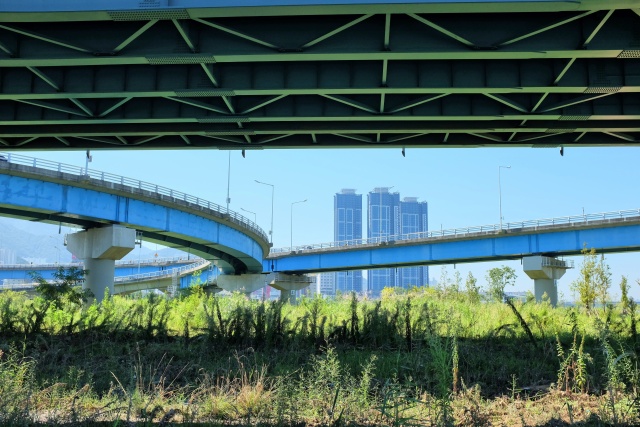
Busan: Bridges

Busan: Nakdonggang Hagutduk Center – end of bike path – here a little paper boat can be folded and deposited into the prepared box
Busan
Passing through the outskirts of Busan, I reached Nakdonggang Hagutduk Certification Center – where I could have received a diploma, if only I'd had my Cycle Pass stamped throughout the trip. I even saw the medal for cycling all 4 cycle trails. It looked nice, memorable. I asked how far it was to Busan center – about 3 hours across hilly terrain. However, the cycle path did not lead there. They suggested I should cycle to the nearest underground station at Hagan and take the Metro. The bike could be transported in the first and last carriages and every station had an elevator. I found the station as well as the elevator. Tickets were a problem though, the sales terminals were only in Korean. I caught up with some boys who helped me and soon I had a ticket to the center for about 30 CZK ($1,5). When changing lines, I searched both for the right direction on the connecting green line and the elevator. It all worked out just fine. After about an hour-long journey and elevator ride, I arrived right in the center amidst the tall buildings.
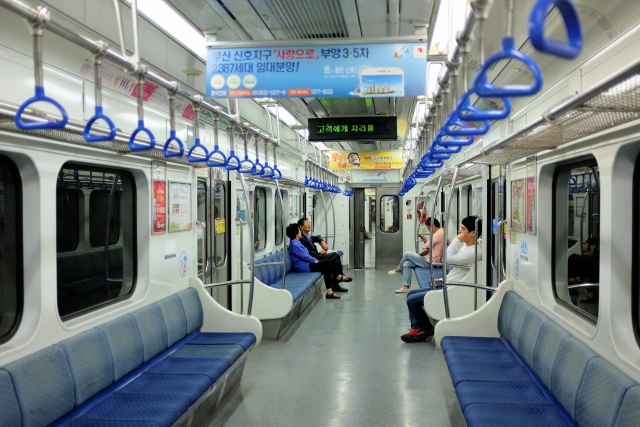
Busan: In the Metro on the orange line
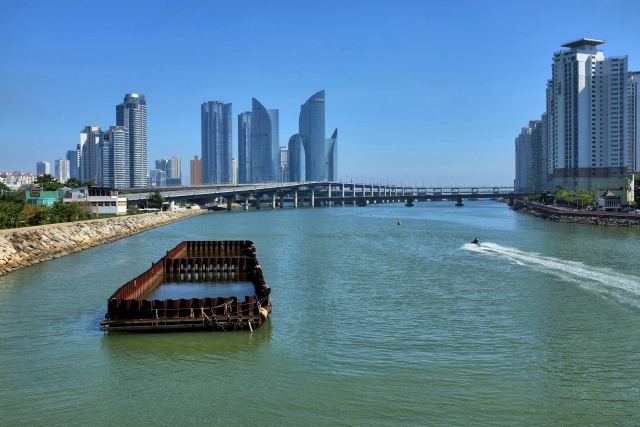
Busan: City center
I was still to find reasonable accommodation, so I consulted my GPS. I found a place with the highest motel density (these are the cheaper local hotels, they have nothing in common with American motels, except the name). After 20 minutes by bike, I reached Gwangalli beach and started to check the motel prices. The rate was the same in all of them (50000 Won, about 1000 CZK or $50). I chose one right next to the sea, let them show me the room. The room on the 6th floor was not a problem as the hotel also had an elevator. The bicycle fitted into it, standing on one wheel, and went easily through the door of my room.

Busan: Gwangalli Beach – my hotel in the background (third building from the left)
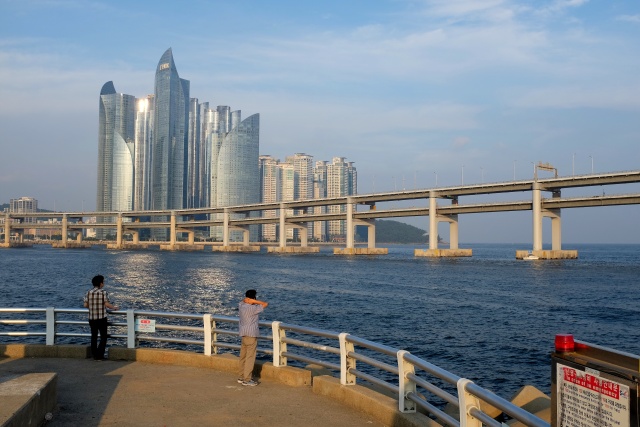
Busan: View of city center from Millak
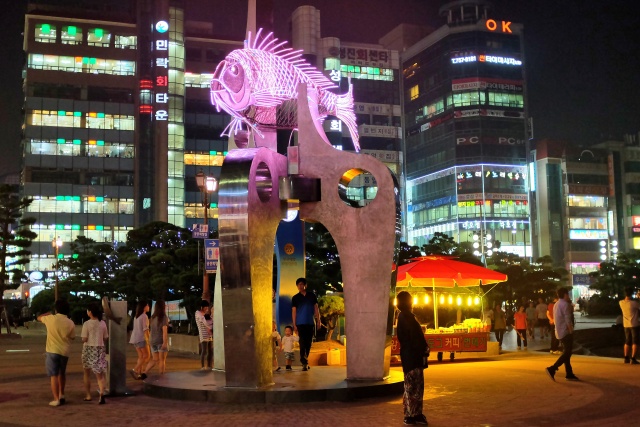
Busan: Fish sculpture at Gwangalli Beach

Busan: Evening on Gwangalli Beach – illuminated Gwangan Bridge in the background
No doubt Busan is more interesting and entertaining than Seoul. Mainly thanks to its location beside the sea, close to some very popular beaches. And if you are accommodated close to one of them, you won't be bored. I was lucky to be in that position. I became acquainted with the local Metro system and started using it to discover more of this vast coastal city surrounded by hills. The ticket machines had an English language option, but it was a bit challenging to locate them. The disadvantage of these machines was that they only accepted notes of 1000 Won (about 20 CZK or $1) or coins. One needed to have the correct change ready. English-speaking assistance could be found on big Metro stations. However, an English version of Busan's tourist map was sufficient to be able to get around. Icons with reference to historical sites close to Metro stations are marked on the map, together with information on how to get there (e.g. Exit 10 and 10 minutes' walk). There are many Metro exits at each station (e.g. 14), all well-marked with details. Some stations are connected to underground stores, some are even several hundred meters long.

Busan: City center – sculpture in front of the mall
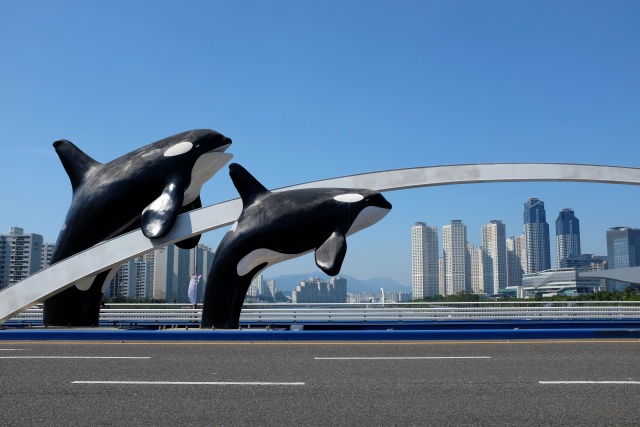
Busan: Bridge decoration in city center
The first day I caught up on my arrears — mainly writing my diary. After midday, I took the Metro to Haeundae, a local beach, only 5 km on foot from Gwangalli beach. Only expensive hotels can be found near that beach, so I was happy to have found Gwangalli where I could sit right beside the ocean. A place under an umbrella on Haeundae beach costs about 140 CZK ($7), unless you go to a zone for tourists and foreigners, which does not have any umbrellas, but is free of charge. A Pilsner beerhall is located right on the beach promenade. This beer is one of the more expensive ones there and is quite well promoted. Cheap Gambrinus, which I'd found in Seoul, was advertised for about 30 CZK ($1) for half a liter. When I returned the next day to buy some more, it already cost double.
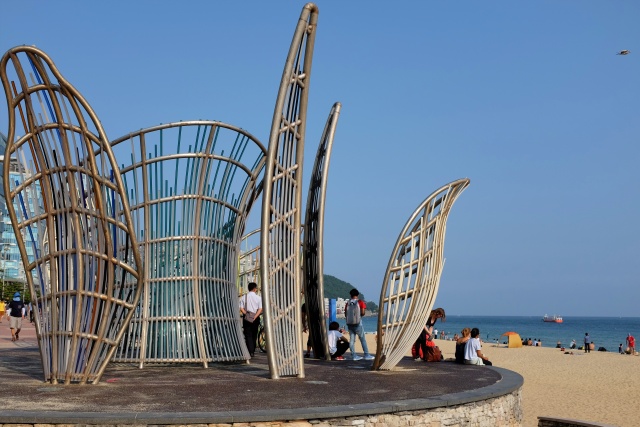
Busan: Sculpture at Haeundae Beach

Busan: Pay section of Haeundae Beach
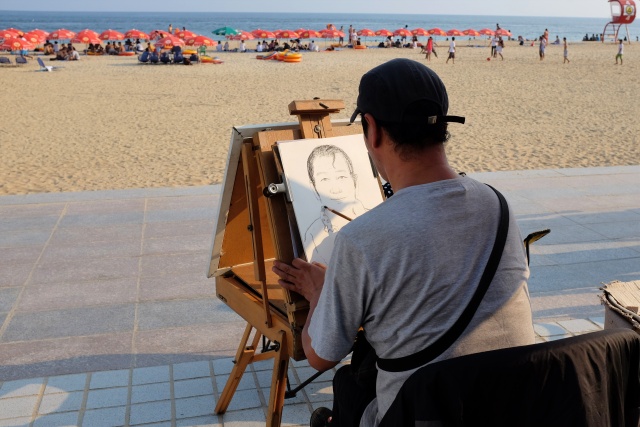
Busan: Street artist
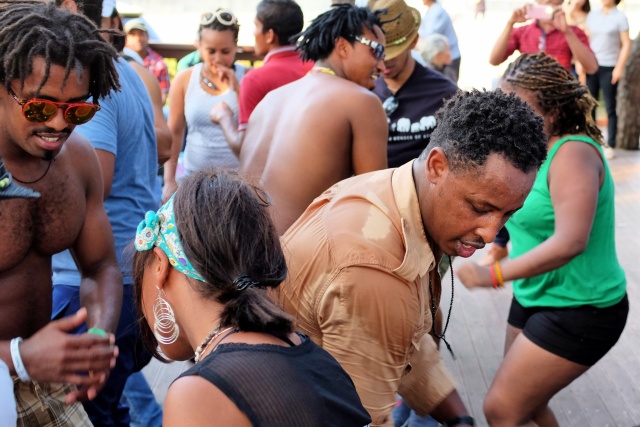
Busan: Members of another ethnic group getting started on the beach
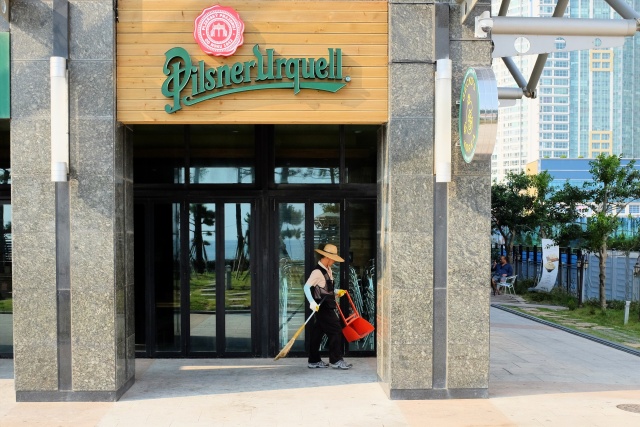
Busan: Pilsner restaurant at Haeundae Beach
On the following day, I purchased a 24-hour Metro ticket (90 CZK or $4) and started to visit the sights systematically. I also longed for and searched for some European food – for example, normal hard cheese (normally one could only find soft cheese there) and something close to European bread. Most importantly, I needed to find a good detailed road map with English names, so I would have something to follow. I was unlucky, as both days (September 8th and 9th) were national holidays and the big shopping malls in Centum City were closed. Yet, according to the advertisements, this was supposed to be the biggest shopping mall in the world. By the way, I have seen many of these "biggest in the world shopping malls"— the last time on the outskirts of Cape Town. I checked out the harbor terminals for ships going to Japan, in case of deciding to travel to Taiwan via Japan. The rest of the afternoon I spent at Jagalchi market, admiring the variety of seafood and tasting it too. Some restaurants featured the "from water to mouth" concept. These were big halls filled with huge containers of live fish, crabs, hedgehogs and heaven knows what else. You point at a fish and soon after that you are eating it. Many of them were consumed raw, so the preparation took only a few seconds. They were tasty and I did not get sick.
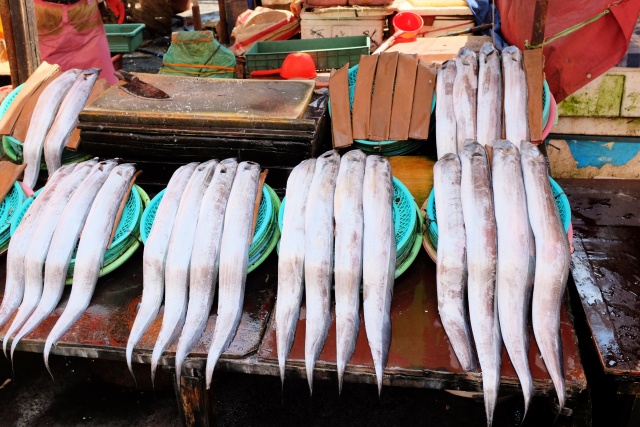
Busan: Jagalchi market offers a wide variety of seafood
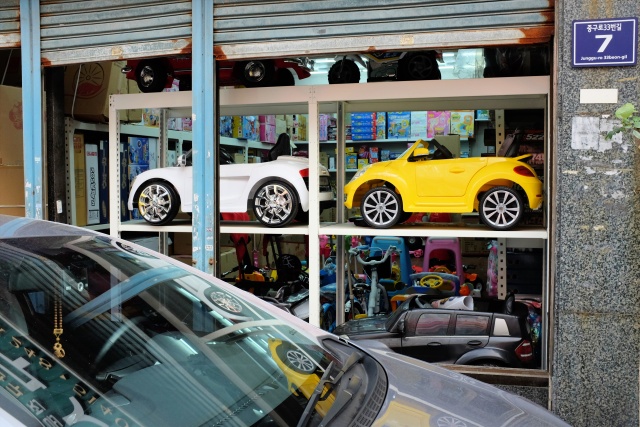
Busan: Jagalchi market – store selling cars for kids
The market, by our standards, is inconceivably vast. It covers an area of about 20 x 20 city blocks, contains plenty of stores and people. Everyone was eating or drinking something and they were all happy. I was too. I managed to buy a road map with English names, which made it more expensive – 600 CZK ($30). The same type or better could be purchased for half the price in the Korean language. It weighed about 1 kg. I had to consider taking it apart and removing the hard cover and unnecessary pages. I even found a shopping mall which was not celebrating the national holiday. On it's 12th floor was a viewing terrace with lawn and a small children's zoo. One floor down, there was a grassy playing field for children. There was a supermarket on the first floor, where I found one type of American hard cheese and something like European bread.

Busan: Underground shopping arcade at Nampo metro station – a sweet girls' store
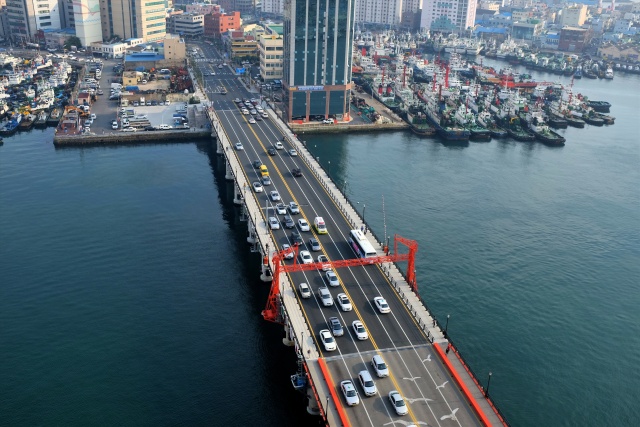
Busan: View from Lotte Mall terrace
